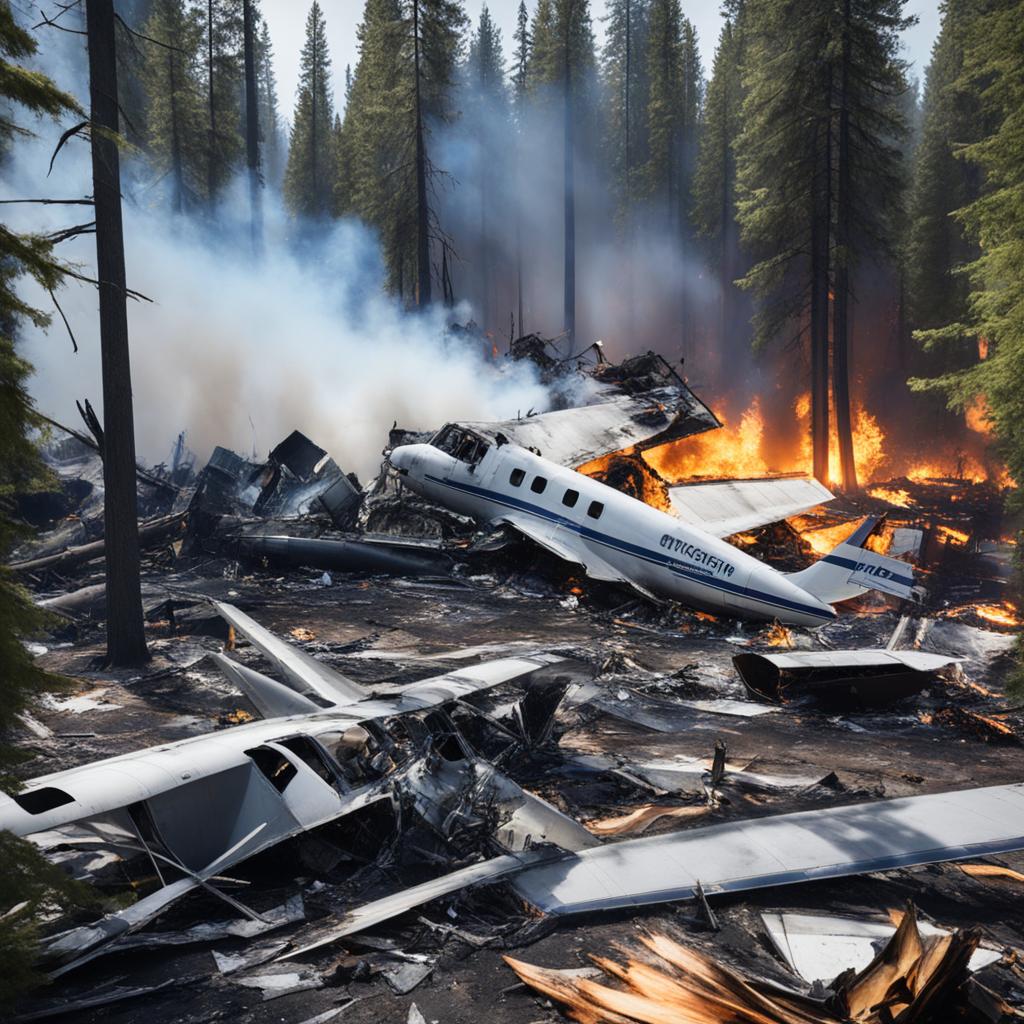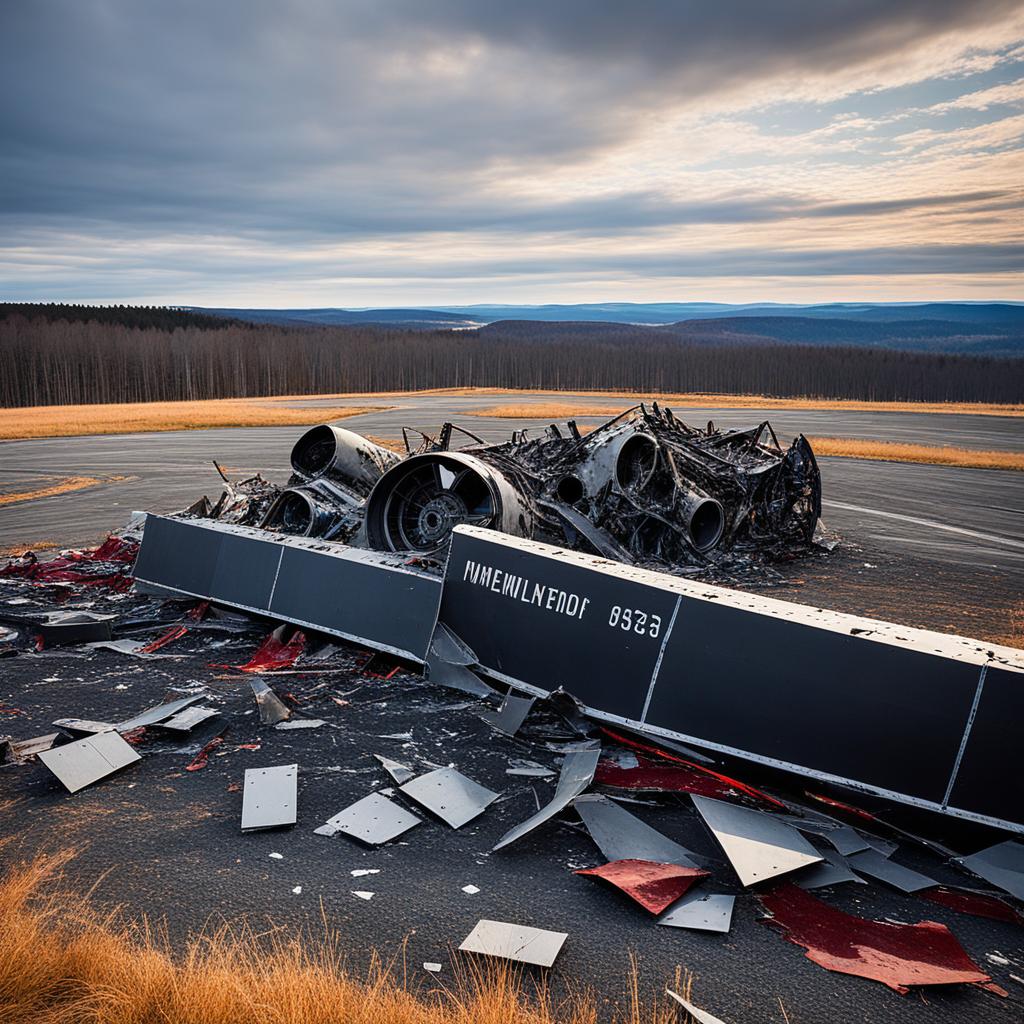On September 11, 2001, United Airlines Flight 93 tragically crashed into a field near Shanksville, Pennsylvania. The impact was so severe that the plane and its occupants were largely obliterated. What happened to their bodies? Where are the remains today? Discover the compelling story behind the burial of the victims and the challenges faced by Somerset County coroner, Wallace E. Miller, in identifying and honoring those who lost their lives.
The Crashing and Burning of Flight 93

On the tragic morning of September 11, 2001, United Airlines Flight 93 met its devastating fate. Traveling at a staggering speed of 575 mph, the aircraft crashed into a field in rural Somerset County, leaving behind unimaginable destruction in its wake. The impact was so forceful that shock waves tore insulation from nearby buildings and caused a high school 12 miles away to shake. The crash resulted in a massive fireball that consumed hundreds of acres of forest and left behind dense, lingering smoke.
The intensity of the crash and subsequent fire largely vaporized the bodies of the passengers and crew, presenting significant challenges for identification. The remains that could be recovered were fragmented, with some even found far from the crash site. It was a grim testament to the sheer power and destructive force of the impact.
This image captures the devastating aftermath of the Flight 93 crash, further emphasizing the magnitude of the tragedy and the desperation of the recovery efforts.
Damage Assessment
The crash of Flight 93 caused extensive damage not only to the aircraft itself but also to the surrounding area. The powerful impact and resulting fireball obliterated the plane and created a widespread path of destruction. Buildings in the vicinity suffered structural damage, with insulation ripped away by shock waves. The fierce heat incinerated vegetation, leaving behind a scarred landscape.
Recovery Efforts
Despite the tremendous challenges posed by the crash and subsequent fire, recovery efforts were undertaken to retrieve any fragments of the victims’ remains. These painstaking efforts, led by Somerset County coroner Wallace E. Miller and his dedicated team, aimed to bring closure to the families of those who perished.
A comprehensive search of the crash site and the surrounding area was conducted, yielding fragments of human remains and personal effects. Cadaver dogs and knowledgeable arborists tirelessly scoured the scene, ensuring no stone was left unturned in the recovery process.
Summary of the Flight 93 Crash
The crash of Flight 93 stands as a solemn reminder of the enormous toll that unfolded on September 11, 2001. The impact, fireball, and subsequent damage left an indelible mark on the landscape and the hearts of those who lost loved ones. The recovery efforts, although challenging, were a testament to the unwavering commitment to honoring the memory of the brave passengers and crew.
Summary of Flight 93 Crash
| Crash Date | Location | Speed | Impact | Fireball | Damage | Recovery |
|---|---|---|---|---|---|---|
| September 11, 2001 | Somerset County, Pennsylvania | 575 mph | Forceful impact causing shock waves and damage to nearby structures | Massive fireball engulfing acres of forest | Extensive destruction to the aircraft and surrounding area | Fragments of remains and personal effects recovered |
The Challenges of Identifying the Victims

Somerset County coroner Wallace E. Miller faced significant challenges in the identification process of the victims from the tragic Flight 93. The intense heat and impact resulted in extensive fragmentation of the bodies, complicating the task of matching remains to individuals. Miller and his team encountered numerous obstacles in their recovery efforts, managing to retrieve only 8 percent of the bodies, with none of them being intact.
The sheer scale of the disaster and the minute size of the remains made the identification process an overwhelming and difficult task. The use of cadaver dogs proved inadequate in locating all the fragments, necessitating the intervention of Penn State arborists who had to climb tall trees to collect the scattered remains. Furthermore, the pervasive odor of death added an additional layer of complexity to the recovery efforts.
- The intense heat and impact caused extensive fragmentation of the bodies.
- Only 8 percent of the bodies were recovered, and none were intact.
- Cadaver dogs were unsuccessful in locating all the fragments.
- Penn State arborists had to retrieve scattered remains from tall trees.
- The recovery efforts were further complicated by the odor of death.
Handling the Remains with Dignity
Due to the inability to identify and preserve the remains of the Flight 93 victims, Somerset County coroner Wallace E. Miller made the decision to bury the fragmented remains at the crash site. The crash site was later designated as a national memorial, honoring the bravery and sacrifice of the passengers and crew.
In June 2018, the remaining wreckage of Flight 93 was transported to the crash site and buried during a private ceremony. The burial took place in a restricted access zone on the sacred ground of the Flight 93 National Memorial. The National Park Service coordinated with the Families of Flight 93 to ensure the respectful handling of the remains.
Returning the Wreckage to the Memorial

After the conclusion of the Federal Bureau of Investigation’s on-site investigation in 2001, the remaining wreckage of Flight 93 was securely stored until it could be returned to the crash site. In 2018, a collaborative effort between the National Park Service, the Families of Flight 93, and the National Park Foundation made it possible to bring the wreckage back to the Flight 93 National Memorial.
The wreckage was ceremoniously buried in a restricted access zone on the sacred ground of the memorial. This significant act marked a milestone in the completion of the memorial’s design, which also included the dedication of the Tower of Voices. This 93-foot structure is adorned with 40 wind chimes, symbolizing the completion of the memorial and paying tribute to the voices of the brave passengers and crew.
| Year | Event |
|---|---|
| 2001 | Conclusion of the on-site investigation and secure storage of the wreckage |
| 2018 | Collaborative effort brings the wreckage back to the memorial and burial in a restricted access zone |
The Reverence of the National Park Service
The National Park Service (NPS) played a crucial role in the preservation of the memory and dignity of the Flight 93 victims. With a deep sense of reverence, the NPS coordinated closely with the Families of Flight 93 to ensure the proper handling and preservation of the remains and personal belongings.
- The NPS conducted a meticulous search of the wreckage prior to its burial to locate any remaining human remains or identifiable personal items.
- They assembled a dedicated collection recovery team consisting of highly trained professionals.
- The team combed through the wreckage with painstaking care, making sure that every possible effort was made to reunite family members with objects belonging to their loved ones.
This attention to detail and commitment to preserving the historical significance of Flight 93 demonstrates the reverence and respect with which the National Park Service carries out its duty.
| Role of the National Park Service | Key Actions |
|---|---|
| Coordinated with the Families of Flight 93 | Ensured the wishes of the families were respected and the remains handled with utmost care |
| Conducted a search of the wreckage | Prior to burial, combed through the wreckage to locate remaining human remains and personal items |
| Assembled a collection recovery team | Professionals meticulously sorted through the debris to recover and identify personal belongings |
Preservation Efforts
The dedication of the National Park Service to preserving history goes beyond the recovery and identification of remains. They have also taken great care in preserving other artifacts and objects associated with the Flight 93 crash. These items are meticulously cataloged, conserved, and displayed within the Flight 93 National Memorial, allowing visitors to gain a deeper understanding of the events and pay their respects.
The Emotional Toll on the Coroner
The task of overseeing the recovery and identification of the Flight 93 victims took an emotional toll on Somerset County coroner Wallace E. Miller. As a public figure representing the families of the deceased, Miller attended memorial ceremonies and played a vital role in ensuring that the victims had a unified voice.
However, the emotional weight of the tragedy led him to limit his attendance at these ceremonies for several years. The 10th anniversary, in particular, reconnected Miller with the families and reminded him of the profound impact of the events.
After many years of service, Miller plans to retire, hoping that the lessons from that fateful September morning will continue to shape history.
The Importance of Remembering Flight 93
Somerset County coroner Wallace E. Miller is a firm believer in the lessons that history can teach us. According to Miller, it is crucial that we remember the events of Flight 93 and honor the heroic actions of the passengers and crew. By preserving the memory of their bravery, we ensure that future generations can learn from their sacrifice and courage.
Miller emphasizes the importance of presenting historical facts and context to provide a thorough understanding of the prevailing circumstances during that fateful September morning. By studying the events surrounding Flight 93, we gain valuable insight into the challenges faced and the resilience displayed by those onboard. These lessons from history serve as guiding principles for the future, enabling us to shape a better and more compassionate world.
The memory of Flight 93 serves as a poignant reminder of the impact that individuals can have in times of crisis. It inspires us to honor and learn from the past, fueling our commitment to creating a safer and more united society. By preserving the memory of this tragic event, we ensure that the sacrifices made by the passengers and crew are never forgotten and that their legacy continues to shape the course of history.
FAQ
Q: What happened to the bodies of the people from Flight 93?
A: The bodies of the people from Flight 93 were largely obliterated upon impact. Only fragments of the victims’ remains were recovered, with none being intact. These fragmented remains were buried at the crash site, which is now a national memorial.
Q: How did Flight 93 crash and what was the impact?
A: Flight 93 crashed at a speed of 575 mph into a field in rural Somerset County. The plane descended rapidly from 3,500 feet, causing shock waves that damaged nearby buildings and shook a high school 12 miles away. The crash resulted in a massive fireball that engulfed hundreds of acres of forest, producing lingering smoke.
Q: What were the challenges in identifying the victims of Flight 93?
A: The intense heat and impact of the crash caused extensive fragmentation of the bodies, making identification difficult. Only 8 percent of the bodies were recovered, and none were intact. Recovery efforts were complicated by the small size of the remains and the need for arborists to climb trees to collect scattered fragments.
Q: How were the remains of the Flight 93 victims handled?
A: Due to the inability to identify and preserve the fragmented remains, the decision was made to bury them at the crash site, which is now a national memorial. The burial took place in a restricted access zone, ensuring the respectful handling of the remains by the National Park Service in coordination with the Families of Flight 93.
Q: What happened to the remaining wreckage of Flight 93?
A: The remaining wreckage of Flight 93 was stored securely until it could be returned to the crash site. In 2018, the wreckage was transported back to the Flight 93 National Memorial and buried in a restricted access zone. This marked a significant milestone in the completion of the memorial’s design.
Q: How did the National Park Service handle the recovery of the Flight 93 wreckage?
A: The National Park Service, in collaboration with the Families of Flight 93 and the National Park Foundation, conducted a search of the wreckage prior to its burial. Their goal was to locate any remaining human remains or identifiable personal items. A collection recovery team meticulously combed through the wreckage to reunite family members with objects belonging to their loved ones.
Q: What was the emotional toll on Somerset County coroner Wallace E. Miller?
A: The task of overseeing the recovery and identification of the Flight 93 victims took an emotional toll on coroner Wallace E. Miller. He attended memorial ceremonies and played a vital role in ensuring the victims had a unified voice. However, the emotional weight led him to limit his attendance at these ceremonies for several years.
Q: Why is it important to remember Flight 93?
A: Somerset County coroner Wallace E. Miller believes it is crucial to learn from the events of Flight 93 and remember the heroic actions of the passengers and crew. History should not be forgotten and serves as a valuable tool for future generations. The memory of Flight 93 serves as a reminder of bravery and the need to honor and learn from the past.
